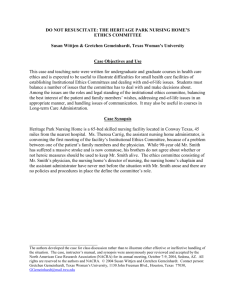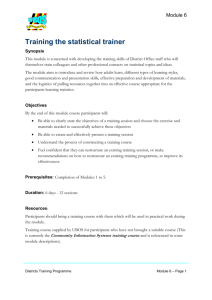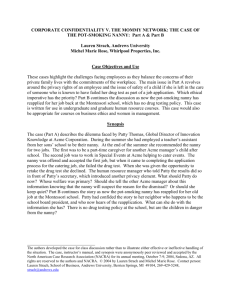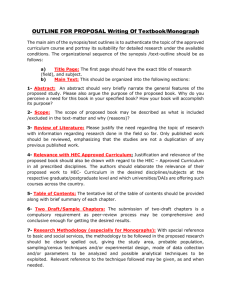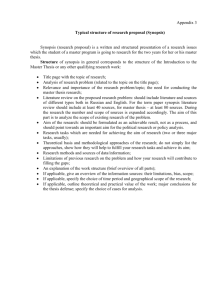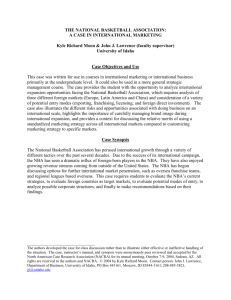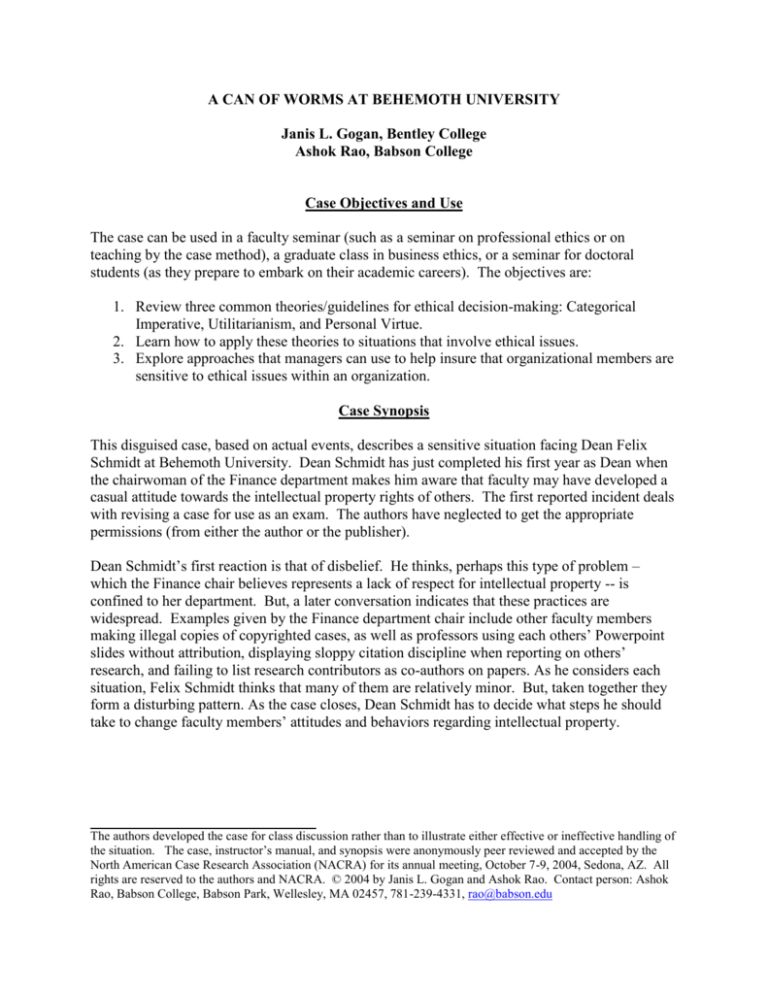
A CAN OF WORMS AT BEHEMOTH UNIVERSITY
Janis L. Gogan, Bentley College
Ashok Rao, Babson College
Case Objectives and Use
The case can be used in a faculty seminar (such as a seminar on professional ethics or on
teaching by the case method), a graduate class in business ethics, or a seminar for doctoral
students (as they prepare to embark on their academic careers). The objectives are:
1. Review three common theories/guidelines for ethical decision-making: Categorical
Imperative, Utilitarianism, and Personal Virtue.
2. Learn how to apply these theories to situations that involve ethical issues.
3. Explore approaches that managers can use to help insure that organizational members are
sensitive to ethical issues within an organization.
Case Synopsis
This disguised case, based on actual events, describes a sensitive situation facing Dean Felix
Schmidt at Behemoth University. Dean Schmidt has just completed his first year as Dean when
the chairwoman of the Finance department makes him aware that faculty may have developed a
casual attitude towards the intellectual property rights of others. The first reported incident deals
with revising a case for use as an exam. The authors have neglected to get the appropriate
permissions (from either the author or the publisher).
Dean Schmidt’s first reaction is that of disbelief. He thinks, perhaps this type of problem –
which the Finance chair believes represents a lack of respect for intellectual property -- is
confined to her department. But, a later conversation indicates that these practices are
widespread. Examples given by the Finance department chair include other faculty members
making illegal copies of copyrighted cases, as well as professors using each others’ Powerpoint
slides without attribution, displaying sloppy citation discipline when reporting on others’
research, and failing to list research contributors as co-authors on papers. As he considers each
situation, Felix Schmidt thinks that many of them are relatively minor. But, taken together they
form a disturbing pattern. As the case closes, Dean Schmidt has to decide what steps he should
take to change faculty members’ attitudes and behaviors regarding intellectual property.
The authors developed the case for class discussion rather than to illustrate either effective or ineffective handling of
the situation. The case, instructor’s manual, and synopsis were anonymously peer reviewed and accepted by the
North American Case Research Association (NACRA) for its annual meeting, October 7-9, 2004, Sedona, AZ. All
rights are reserved to the authors and NACRA. © 2004 by Janis L. Gogan and Ashok Rao. Contact person: Ashok
Rao, Babson College, Babson Park, Wellesley, MA 02457, 781-239-4331, rao@babson.edu
CLEAN BALANCE SHEETS AND CLEAN CONSCIENCES
William A. Andrews & Monique Forte
Stetson University
Case Objectives and Use
The case is designed to challenge students to grapple with the ethics of management’s engaging
a plan to take advantage of novice and careless investors, though all would be done in a strictly
legal fashion. The case is useful in an upper division undergraduate course or MBA course
covering business and society, business ethics, business law, finance, entrepreneurship, or
strategic management.
Case Synopsis
In this short case, the student must resolve an ethical dilemma faced by the CEO of a small
aircraft manufacturer. This publicly-traded company is in technical default on its debt, but is
experiencing significant growth in its main, revitalized operating division. A stock promoter
specializing in penny stocks has given the CEO, Dwayne White, ample reason to believe that he
can easily get the stock price up to a level that would trigger conversions of the convertible debt
that threatens the welfare of this undercapitalized company. The promoter believes that he can
easily get the valuation up by a factor of 5 since most traders watch momentum and few read the
details of the 10k, where the enormous dilution associated with the conversion is revealed.
Moreover, he has a track record that substantiates his claims. The CEO, who himself believes
that such a valuation has no long-term substance, and significantly exceeds any reasonable basis
for valuation, has reservations about engaging the services of the promoter. Personally, he
stands to gain as a 3% shareholder. The company stands to gain by eliminating $30 million in
debt and removing its default status, but these funds would come from investors and traders who,
like most, don’t dig deep into the 10k to know what is really happening with the financial
reports. Should White engage the promoter, knowing that the company will benefit by
victimizing small investors?
The authors developed the case for class discussion rather than to illustrate either effective or ineffective handling of
the situation. The case, instructor’s manual, and synopsis were anonymously peer reviewed and accepted by the
North American Case Research Association (NACRA) for its annual meeting, October 7-9, 2004, Sedona, AZ. All
rights are reserved to the authors and NACRA. © 2004 by William Andrews and Monique Forte. Contact person:
William Andrews, School of Business Administration, Stetson University, DeLand, FL 32723, 386-822-9786,
wandrews@stetson.edu
IBM AND THE WORKPLACE CANCER LAWSUIT
Tiffany Schleeter, San Jose State University
Case Objectives and Use
This case focuses on the ethical and legal obligations of the semiconductor industry for the safety
and health of their employees. Under California Labor Code 3602(b)(2), are these companies
guilty of fraudulently concealing employee injuries caused by chemical exposure? Are the
actions of these businesses toward their employees unethical? What, if anything, can or should
be done differently? What should the semiconductor industry do now to avoid future similar
lawsuits? What ethical obligations should the semiconductor industry have to its employees’
safety and health? This case is suitable for graduate or upper-division undergraduate courses in
business and society, business ethics, or business law. It is especially useful in modules dealing
with ethical and legal obligations of employers to employees and in those on occupational safety
and health. This case was written based on personal observation and public sources, including
news articles in print and online as well as legal documents such as trial transcripts and briefs
submitted by both the plaintiffs and the defendant. A full bibliography appears with the case.
Case Synopsis
This case focuses on a 2004 lawsuit against IBM that claimed the company fraudulently
concealed work related employee injuries, which caused those injuries to develop into cancer.
This was the first of many lawsuits filed against IBM to come before a jury. Jim Moore and
Alida Hernandez, the plaintiffs, worked with carcinogenic chemicals at IBM’s San Jose,
California plant for several years. During their employment they complained of symptoms of
systemic chemical poisoning. IBM doctors did not diagnose systemic chemical poisoning and
both Hernandez and Moore were returned to their regular duties. Hernandez was diagnosed with
breast cancer in 1993, just two years after her retirement. Moore was diagnosed with nonHodgkin’s lymphoma after working twenty-seven years for IBM. Several other employees across
the nation have claimed IBM was responsible for cancers and birth defects. A number of
environmental activists and human rights organizations have called for studies to examine the
relationship between toxic exposure to chemicals on the job and cancers and birth defects within
the semiconductor industry. This case describes the evidence and testimony of both the plaintiffs
and the defendant as well as the relevance of California Labor Code 3602(b)(2) and how it
applies to IBM’s trial. The case closes with the jury entering into deliberations to determine if
IBM was guilty of fraudulently concealing systemic chemical poisoning caused by chemical
exposure on the job, which led to Hernandez’s and Moore’s cancers.
The author developed the case for class discussion rather than to illustrate either effective or ineffective handling of
the situation. The case, instructor’s manual, and synopsis were anonymously peer reviewed and accepted by the
North American Case Research Association (NACRA) for its annual meeting, October 7-9, 2004, Sedona, AZ. All
rights are reserved to the author and NACRA. 2004 by Tiffany Schleeter. Contact person: Tiffany Schleeter,
College of Business, San Jose State University, 676 Menker Avenue, San Jose, CA 95128, 408-288-9982,
trs3268@aol.com
MEXICO, MITSUBISHI, AND THE GRAY WHALE: A CASE STUDY OF LAW,
ETHICS, AND ENVIRONMENTAL ISSUES IN INTERNATIONAL BUSINESS
Lisa Johnson
The University of Puget Sound
Case Objectives and Use
This case illustrates conflicts among diverse stakeholders concerning a proposed development by
a foreign corporation in an environmentally sensitive area in Mexico. It examines the ethical
implications of international business decisions that may result in adverse environmental or
economic consequences, including an irreversible decline of an endangered species, substantial
harm to the Mexican economy, or a world-wide shortage of salt. It highlights the evolvement of
international environmental law and serves as a model of comparative environmental law
between the United States and Mexico. The environmental issues, which are implicit in the
business, legal, and ethical questions raised by this case, mirror the modern business climate in
which decision makers must act. The case was written for business or public affairs
undergraduate courses in ethics, legal studies, international business, public management, or
environmental issues.
Case Synopsis
Mitsubishi Corporation predicated an impending world-wide shortage of salt, and proposed to
develop the world’s largest salt mining operation at Laguna San Ignacio, which is located within
an environmentally protected area in Baja California Sur, Mexico. Laguna San Ignacio contains
the last pristine gray whale nursery along the Pacific migratory corridor. Gray whales, an
endangered species, are protected by several international and domestic legal instruments
including treaties and Mexican law. They travel to Laguna San Ignacio to calve.
The salt mining plans drew conflicting reactions among many stakeholders, including private
businesses, governments, environmental non-governmental organizations, and the local and
international populations. Many argued that salt mining is inconsistent with environmental
protection, while others maintained that salt mining is environmentally benign. Should this have
been strictly a Mexican domestic decision? The possible environmental degradation of a transboundry resource – the gray whale – led to international interest. This case examines various
stakeholders’ interests, motivations, and positions related to the environmental, ethical, and legal
issues raised by this conflict. It presents conflicting arguments and evidence, and allows students
to analyze the facts, develop a plan of action, and ultimately defend their decision.
The author developed this case for class discussion rather than to illustrate either effective or
ineffective handling of the situation. The case, instructor’s manual, and synopsis were
anonymously peer reviewed and accepted by the North American Case Research Association
(NACRA) for its annual meeting, October 7-9, 2004, Sedona, AZ. All rights are reserved to the
author and NACRA. © 2004 by Lisa Johnson. Contact Person: Lisa Johnson, School of
Business and Leadership, The University of Puget Sound, 1500 North Warner, McIntyre 111G,
Tacoma, WA 98416-1032, (253) 879-2870, ljohnson@ups.edu
MISSION FEDERAL CREDIT UNION
Craig P. Dunn, San Diego State University
Brian K. Burton, Western Washington University
Case Objectives and Use
This case showcases in a financial services environment issues related to community obligation
and community enhancement programs, and it includes issues of politics and decision making in
organizations. It has several objectives: students will gain information about the decisionmaking process at the board level of large organizations; they will explore the pros and cons of
social entrepreneurship; and they can debate the proper purpose of an organization and how best
to fulfill that purpose. This case is appropriate for courses in business and society and business
ethics. It also would be appropriate for courses in strategic management. The decisions are
complex enough, particularly because of the nature of the organization, that graduate students as
well as undergraduates will find the case interesting and challenging.
Case Synopsis
John Parsons, a senior vice president with Mission Federal Credit Union in San Diego, needed to
decide whether to support an initiative from a member of the credit union’s board of trustees to
open a student-run branch in downtown San Diego. Such a branch would be ground-breaking –
the first student-run credit union branch in the country open to the general community; it would
fit with Mission Federals general philanthropic outlook; it would be an example of social
entrepreneurship and strategic philanthropy; and it had other advantages. But it would be located
in an area away from current members; it would take money away from other philanthropic
efforts supported by long-term board members and give it to an effort proposed by a new and
aggressive board member; and it had other problems. Furthermore, such support might prove to
be long-term in nature, as the branch would become profitable only in the long run, if ever.
Parsons needed to decide just how much he believed in this project.
The authors developed the case for class discussion rather than to illustrate either effective
or ineffective handling of the situation. The case, instructor’s manual, and synopsis were
anonymously peer reviewed and accepted by the North American Case research
Association (NACRA) for its annual meeting, October 7-9, 2004, Sedona, AZ. All rights
are reserved to the authors and NACRA. © 2004 by Craig P. Dunn and Brian K. Burton.
Contact person: Brian Burton, College of Business & Economics, Western Washington
University, 516 High Street, Bellingham, WA 98225-9072, 360-650-3389,
Brian.Burton@www.edu
PREMIER DATA SOLUTIONS CASE
Hugh Grove, Tom Cook, & Oliver Burns
University of Denver
Case Objectives and Use
The major decision problem is to make a recommendation for the potential acquisition of
Premier Data Solutions (PDS), and, if positive, to support it with an acquisition price, a
form of union, deal structure, and negotiating strategies to close the deal. The acquiring
company is under pressure to maintain its revenue growth and earnings targets set by
financial analysts. Therefore, an important consideration is the impact on earnings from
the application of the new merger and acquisition (M&A) accounting requirements. The
key decision maker must estimate net income and free cash flows as one basis for valuing
PDS. Since PDS is privately held, estimating appropriate valuation multiples and the
weighted average cost of capital will be challenging. This case is intended for graduate and
senior level courses in finance and accounting. Case topics include financial forecasting,
business valuation methods, financial benchmarks, and M&A accounting.
Case Synopsis
The students are challenged to make a recommendation concerning the acquisition of a
company that helps the acquiring company integrate down-stream in a vertical merger.
This acquisition recommendation must include both a financial valuation of the company
and a deal structure to close the sale. The students take the role of Oliver Burns, Vice
President of Business Development, who is in charge of making this recommendation to
Ron Nelson, Executive Vice President for Business Development. The acquiring company
is under pressure to make the earnings projections of the financial analysts and maintain
its strong record of double-digit revenue growth. Deals that cause near-term dilution of
earnings may be rejected even if they have positive net present values. Thus, the
application of the new M&A accounting requirements is important for the impact on
earnings. Oliver has the tasks of performing due diligence, coming up with a valuation of
PDS, assessing the M&A accounting impact on earnings, and suggesting broad deal
structure terms and negotiating strategies. The goal is to determine whether the merger
could be beneficial to both parties if a fair price and deal structure can be worked out.
The major decision problem is to make a recommendation concerning the potential
acquisition of PDS, and to support it with an acquisition price, a type of alliance, deal
structure terms, and negotiating strategies to close the M&A deal.
The authors developed the case for class discussion rather than to illustrate either effective or ineffective
handling of the situation. The case, instructor’s manual, and synopsis were anonymously peer reviewed and
accepted by the North American Case Research Association (NACRA) for its annual meeting, October 7-9,
2004, Sedona, AZ. All rights reserved to the authors and NACRA. © 2004 by Hugh Grove, Tom Cook, and
Oliver Burns. Contact person: Hugh Grove, Daniels College of Business, University of Denver, 2101 S.
University Blvd., Denver, CO 80208, 303-871-2026, hgrove@du.edu
THE SCARIEST DECISION:
RICK DUBROW, A-1 BUILDERS, AND PRO-WHATCOM
Brian K. Burton, Western Washington University
Case Objectives and Use
This case is designed to get students to think about how their personal values might coincide
with the business in which they are operating. Although the subject of the case (sustainability
and growth issues) might be fairly specific to the industry in which Rick Dubrow was operating
(construction), the more general issues are not. For example, an attorney or accountant might
have personal values deeply opposed to actions of a potential client. This case allows students to
gain an understanding of the issues involved in such decisions. Also, this case allows students to
examine ethical decision-making in a case that is personal in nature instead of one that focuses
strictly on a business decision in which personal values might be seen to be less important. It
helps the students focus on the importance of ethics in a business context because of the personal
nature of the decision.
Case Synopsis
Rick Dubrow, the owner of A-1 Builders of Bellingham, Washington (primarily a remodeling
firm), was faced with a decision that potentially brought his personal values and his business into
conflict. Long a proponent of sustainable business practices in the construction industry, Dubrow
had made a name for himself and his company. But now his long interest in population issues
had led to an interest in becoming a public face of a new organization, Pro-Whatcom, which was
pursuing what many saw as an anti-growth agenda. Dubrow knew that sustainability in
construction was one thing, but limiting growth (and thus the business of construction-related
firms) was another entirely. A backlash within the construction community, perhaps even among
his own firm’s employees, was possible. Yet his personal values agreed with those espoused by
the organizers of Pro-Whatcom.
The author developed the case for class discussion rather than to illustrate either effective or ineffective handling of
the situation. The case, instructor’s manual, and synopsis were anonymously peer reviewed and accepted by the
North American Case Research Association (NACRA) for its annual meeting, October 7-9, 2004, Sedona, AZ. All
rights are reserved to the authors and NACRA. © 2004 by Brian Burton. Contact person: Brian Burton, Department
of Management, College of Business & Economics, Western Washington University, 516 High Street, Bellingham,
WA 98225-9075, 360-650-3389, Brian.Burton@wwu.edu
SONY ONLINE ENTERTAINMENT: EVERQUEST® OR EVERCRACK?
Judith W. Spain, Eastern Kentucky University
Gina Vega, Merrimack College
Case Objectives and Use
This case is designed to help students develop investigative skills by examining the conflict
between corporate and personal responsibility. To that end, the case addresses the competing
issues of online addiction and addictive personalities with protection against restraint of trade,
and raises consideration of various options for marketing strategies for EverQuest II®, a second
generation MMP fantasy online game developed by SONY. One goal of this case is to evaluate
the public relations ramifications of the negative publicity generated due to two deaths connected
with the game versus the positive publicity generated by the public popularity of the game. This
case was written for use by undergraduate students in a business program and can be used readily
in the undergraduate or graduate classroom in connection with issues of consumer law, business
ethics, electronic addiction, and organizational behavior. It has successfully been used as the
centerpiece of an Ethics Awareness Week program.
Case Synopsis
SONY Online Entertainment (SOE) was planning to release a new version, EverQuest II®, of its
popular online game, EverQuest®. The first EverQuest® game was very successful financially,
generating approximately $5 million/month in 2002 for SOE. However, some issues
surrounding addictions and corporate responsibility were interfering with the new product
launch.
These problems revolved around several deaths in which the EverQuest® game had been
implicated. One death, the suicide of Shawn Woolley, attracted significant media attention
because the game was still running on his computer when he was discovered by his mother, two
days after missing Thanksgiving dinner with a rifle at his side. The other death was of a young
child whose father had thrown him into a closet after his crying disrupted the father’s
concentration on the game. The case focuses on the dilemma faced by Scott McDaniel, the Vice
President of Marketing, prior to the new product release: How far must a company go to protect
possible misuse of a product by consumers? Was there something he should be doing besides
preparing the ad campaign?
The authors developed the case for class discussion rather than to illustrate either effective or ineffective handling of
the situation. The case, instructor’s manual, and synopsis were anonymously peer reviewed and accepted by the
North American Case Research Association (NACRA) for its annual meeting, October 7-9, 2004, Sedona, AZ. All
rights are reserved to the authors and NACRA. © 2004 by Judith W. Spain and Gina Vega. Contact person: Gina
Vega, Francis E. Girard School of Business and International Commerce, Merrimack College, 315 Turnpike Street,
North Andover, MA 01845, 978-837-5000, ext 4338, gina.vega@merrimack.edu
UNOCAL AND THE AUTO/OIL STUDY GROUP: THE FEDERAL TRADE
COMMISSION CLAIMS “PATENT AMBUSH”
Darren Kiekel, Jayhawk Pipeline
Nan Muir Bodensteiner & Mavis Cheney Sauer, University of Houston Clear Lake
Case Objectives and Use
The case was written to illustrate the issues, decisions and problems Unocal faced as it engaged
in a collaborative research effort with competitors participating in a state environmental
regulatory process, while simultaneously pursuing an independent parallel research stream that
culminated in patented intellectual property. The case illustrates: decisions encountered in
research and development; the collaborative, yet competitive aspects of research and
development in an industry consortium founded to address (future) government regulations; and,
the competitive, ethical and legal challenges that arose in the commercialization of intellectual
property. The case was written for business school graduate courses in business strategy and
management of technology.
Case Synopsis
In 1989, a time of increasing evidence linking automobile emissions to poor air quality in major
metropolitan areas, fourteen major petroleum refiners and the big three U.S. auto manufacturers
launched a joint research effort, the Auto/Oil Study Group, to study how motor gasoline might
be reformulated to reduce emissions. The program was a proactive move to address new gasoline
regulations under development at the state and federal level. Unocal, a founding member of the
group, was independently studying reformulated gasoline (RFG) prior to the group’s formation.
As Unocal actively participated in the study group and maintained proactive involvement in the
industry/government discussions on environmental regulations they quietly filed for patents on
their independent RFG research. When the California Air Resources Board (CARB) created
environmental regulations based on their research results they had to manage the competitive
advantage issues and decisions involved in commercializing their findings. Unocal made
strategic decisions concerning the protection of their intellectual property and the timing of
disclosure of their commercialization activities. Balancing the sometimes-competing activities,
striving to act in the best interests of stakeholders, while commercializing the new technology
was a daunting task. Ultimately, Unocal’s decisions led to public criticism, legal challenges
instigated by study group members, investigations by the Federal Trade Commission and
reviews by the U.S. Patent Office. How to manage the societal and competitive issues and
ensuing intellectual property challenges that arose are the central issues of the case.
The authors developed the case for class discussion rather than to illustrate either effective or ineffective handling of
the situation. The case, instructor’s manual, and synopsis were anonymously peer reviewed and accepted by the
North American Case Research Association (NACRA) for its annual meeting, October 7-9, 2004, Sedona, AZ. All
rights are reserved to the authors and NACRA. © 2004 by Darren Kiekel. Nan Muir Bodensteiner and Mavis
Cheney Sauer. Contact person: Nan Muir Bodensteiner, University of Houston Clear Lake, Box 234, 2700 Bay
Area Blvd. Houston, TX 77058, 281-283-3241, muir@cl.uh.edu




